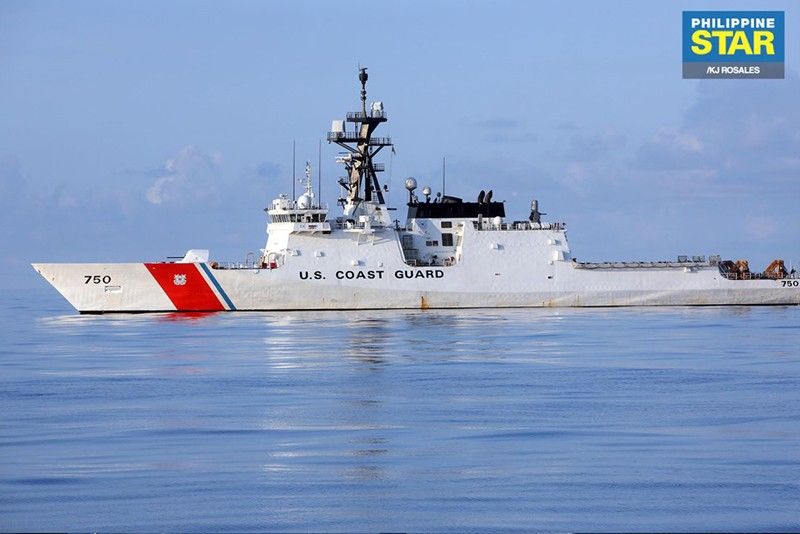US-China trade war could spill over to South China Sea

WASHINGTON – The trade war between the United States and China is raising the possibility that tensions could extend beyond trade and affect other areas of contention between them including the South China Sea, analysts here warned.
The warning came as guided-missile destroyer USS Preble on Monday sailed within 12 nautical miles of Panatag (Scarborough) Shoal to “challenge excessive maritime claims and preserve access to the waterways as governed by international law,” said a US 7th Fleet spokesman.
It was the second time in the past week that a US warship sailed near Panatag, which Filipinos also call Bajo de Masinloc.
The Coast Guard cutter Bertholf and two Philippine Coast Guard vessels practiced search-and-rescue operations on May 14 near Panatag, the US Navy said.
Since the start of the year, the US Navy is reported to have conducted four freedom of navigation exercises near disputed islands in the South China Sea, most of which is claimed by Beijing even as China and the United States continue trade talks aimed at easing the escalating tariffs each country has imposed on the other.
The Washington Post said the United States for years has relied on economic interdependence with China as a stabilizing force in their ties, with business between the two nations forming a so-called ballast in US-China affairs.
But as their trade dispute escalates and damages economic ties, “there is reduced incentive for stability and restraint in Washington when it comes to China,” it said.
President Donald Trump was the first to impose tariffs on Chinese goods to reduce America’s massive trade deficit with China. He escalated the tariffs progressively to punish the Chinese for forcing US and foreign businesses to hand over their priced technology in exchange for access to local markets. China has retaliated every step of the way.
The Chinese foreign ministry said Preble’s sailing near Panatag was trespassing and clearly an “unpopular” move.
“In disregard of the regional countries’ shared aspiration for peace and stability in the South China Sea, the US has been disrupting regional peace and stability time and again under the pretext of ‘freedom of navigation and overflight,’” said foreign ministry spokesman Lu Kang at a press conference in Beijing.
“Such action is unpopular. We strongly urge the US to stop such provocation lest it should harm China-US relations and regional peace and stability,” he said.
He added that China would continue to take all necessary measures to defend its sovereignty and safeguard peace and stability in the South China Sea.
“I have to stress again that the trespass of US warship is a violation of China’s sovereignty. It undermines peace, security and good order in the relevant waters. China firmly opposes such move,” Lu said.
Fight for sovereignty
In Manila, presidential spokesman Salvador Panelo said the administration will assert the country’s sovereignty in case Beijing pushes through with its fishing ban in the West Philippine Sea.
“The policy of the government will always be consistent with its policy that it will assert its sovereignty over the areas claimed to be its own. So, it will always pursue that line,” Panelo said when asked for the government’s response if China extends the ban to waters within the Philippines’ exclusive economic zone.
The fishing ban – which began on May 1 – is until Aug. 16.
Asked if he finds the ban objectionable, Panelo also said “draw your conclusion, that’s against the sovereignty – that’s our position.”
“In other words, we will always be consistent. But I will leave that to the Secretary of Foreign Affairs to make a direct statement on that,” he said.
Clam poachers back
But security is not the only issue bedeviling the South China Sea. Washington-based think tank Asia Maritime Transparency Initiative (AMTI), in a report, said Chinese clam harvesting vessels are back in disputed waters – with Beijing’s blessings.
Citing images taken in the last six months, AMTI said China’s “most destructive boats have returned to the South China Sea in force” after a sharp drop in giant clam harvesting activities from 2016 to 2018.
“These fleets, which typically include dozens of small fishing vessels accompanied by a handful of larger ‘motherships,’ destroy vast swaths of coral reef in order to extract endangered giant clams,” the AMTI reported.
The clams are transported back to Hainan province where they fetch thousands of dollars each in a thriving market for jewelry and statuary, it said.
Since late 2018, satellite imagery has shown these fleets operating frequently at Panatag Shoal and throughout the Paracels, including in the Bombay Reef area, the think tank said.
The AMTI said the return of the Chinese poachers to Panatag Shoal remains a particularly sensitive issue between the Philippines and China as the reef was already extensively damaged by the earlier phase of clam harvesting up to 2016.
“But (satellite) imagery from December 2018 reveals the return of a large number of clam boats. A comparison of imagery from December and March also reveals new scarring on the reef from recent extraction,” the report stated.
Satellite images taken in March appear to show large piles of extracted clams tagged and deposited across the reef for later collection by the Chinese poachers.
The claim piles, visible as irregular white spots scattered around the reef, were not present in previous images.
New poaching method
The common method employed by poachers involve anchoring their boats and then dragging the reinforced propellers of their outboard motors across the reef surface to break up the coral, allowing the clams to be easily lifted out while sending sediment drifting throughout nearby waters.
“The ecological results were devastating and, as a result, in July 2016 the arbitral tribunal that ruled on a case brought against Beijing by Manila found that China had violated its obligations under international law to protect the marine environment,” the AMTI said.
Despite the clear and serious ecological destruction caused by the clam-harvesting vessels, Chinese coast guard ships were not taking any action against the poachers, it said.
While the AMTI has not found clear evidence of new clam harvesting in other parts of the South China Sea, imagery taken last April 7 showed Chinese maritime militia vessels were clustering around Philippine-occupied Kota (Loaita) Island and Melchora Aquino (Loita) Cay.
“That suggests that for every clam harvesting operation that is documented in the South China Sea, others will go unnoticed. But with tens of thousands of acres of reef surface already damaged or destroyed and fish stocks teetering on the brink of collapse, the effects of this wanton destruction of the marine environment will be felt across the region,” the think tank warned. – With Pia Lee-Brago, Paolo Romero, Christina Mendez
- Latest
- Trending


























